Alignment of Road | Alignment in Design | Horizontal Alignment of Road | Vertical Alignment of Road
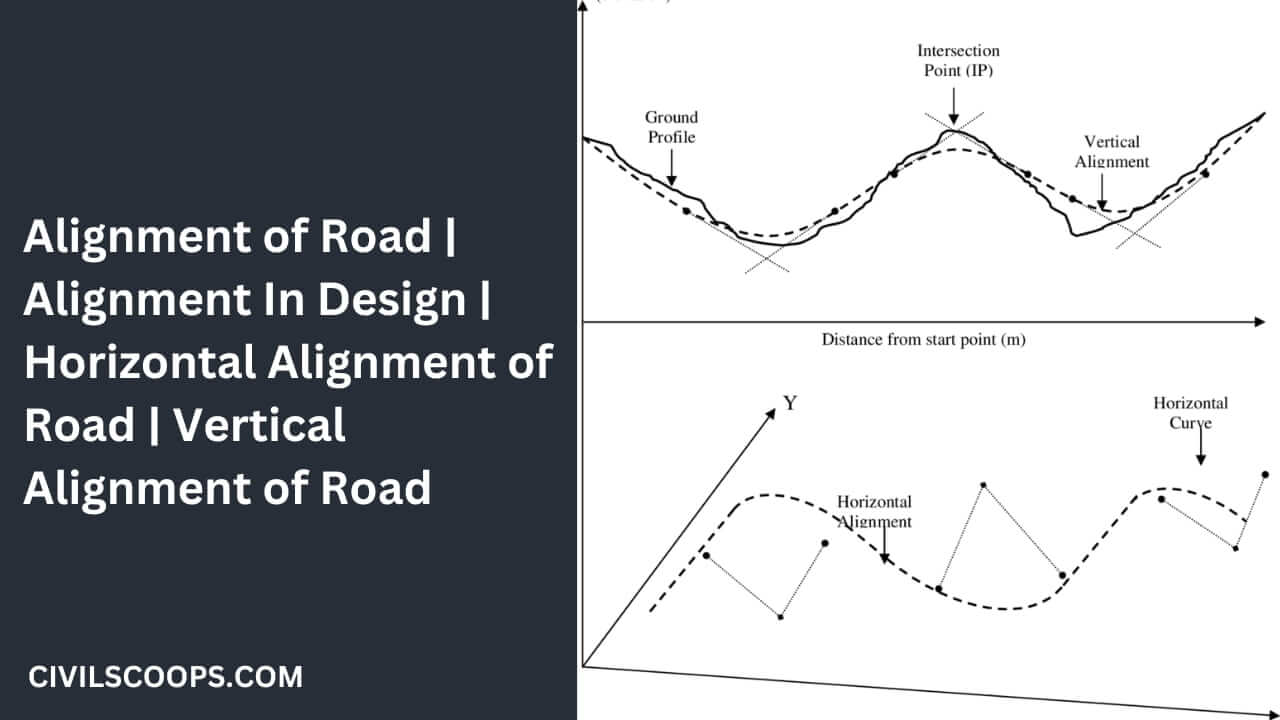
Table of Contents
Alignment of Road:
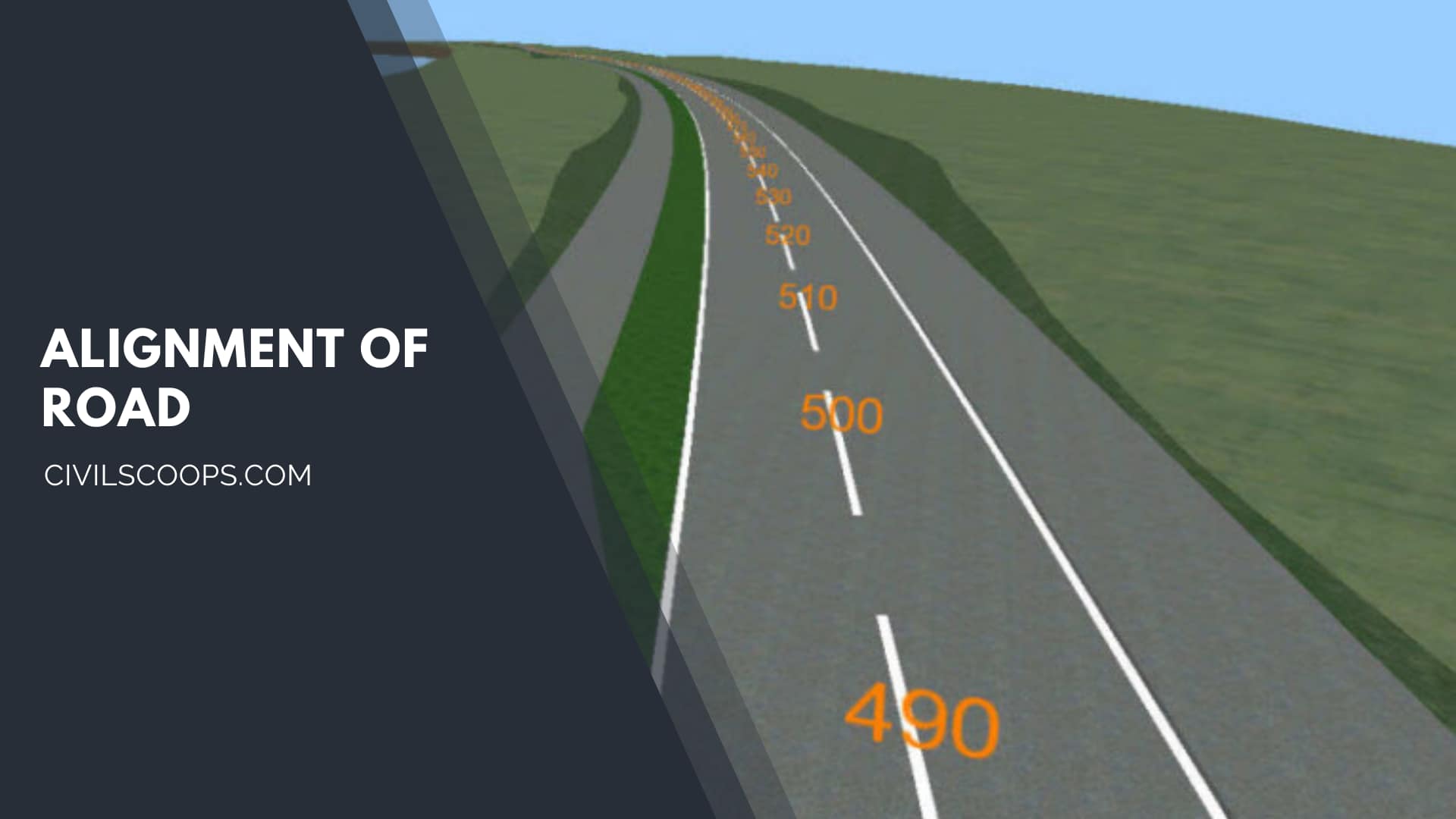
Alignment is the center line position of the highway on the ground; it is also termed highway alignment.
The alignment guides the good pass of the road through the right Alignment, which is the most economical and easy to construct.
There are mainly two types of alignment-
Horizontal Alignment: It includes a straight line, curve, etc.
Vertical Alignment: It includes vertical or horizontal alignment.
Alignment is a series of points, lines, curves, etc. To construct a road, we need to locate those points properly.
The Centreline of a road follows the horizontal alignment and the vertical gradient follows the vertical gradient.
Also Read: What Is Road Pattern | Different Types of Road Patterns
Alignment in Design:
Basic Requirements of Ideal Alignment:
The basic requirements of an ideal configuration are as follows.
- Short.
- Easy.
- Safe.
- Economical.
- Useful.
1. Short:
- The alignment must be as short as possible between the two stations.
- This is the main reason why alignments are as straight as possible.
2. Easy:
- Alignment should be effortless to construct and maintain, and it should be with an easy gradient and curve.
3. Safe:
- The alignment must have safe geometric properties, stable natural hill slope, cut slope, and embankment, and should be safe for safe traffic operation.
4. Economical:
- The alignment must be economical, including the initial cost, operation cost, and maintenance cost.
5. Useful:
- The alignment should be used for maximum population places and products.
Factors Controlling Alignment:
The basic requirements of an ideal configuration are as follows.
- Obligatory Points.
- Economy.
- Geometric Design.
- Traffic.
- Other Considerations.
1. Obligatory Points:
- Obligatory points are those points where the road alignment has to pass with the shortest distance.
- The obligatory points of a road should not pass and should be avoided when the road alignment is done.
- These points are observed between the intermediate town, bridge, mountain pass, etc.
2. Economy:
- When we finalize the alignment of the road, then we need to consider this factor also.
- We need to take some conditions like working out the economy, initial cost, cost of maintenance, vehicle operation, etc.
- Initially, the construction cost can be decreased by selecting the cutting filling balanced alignment.
3. Geometric Design:
- We need to consider those geometric factors like sight distance, gradient, the radius of the curve, etc.
- The alignment should be provided with adequate safe sight distance and enough overtaking sight distance.
- The new road alignment should be flat and less than the ruling gradient.
- Sometimes alignment is to be changed to adjust the alignment of the road to receive the radius of the curve.
4. Traffic:
- Before we construct the alignment of any road, we need to study the nature of traffic on that road properly.
- From this property, we can easily find out the nature of traffic like slow-moving traffic or speedy traffic.
- In slow-moving traffic will be curling nature by joining all the villages and sharp curves but where the speed of traffic is more then we construct straight roads with easy curves.
5. Other Considerations:
- Other factors like hydrological factors, political considerations, monotony, and drainage considerations have governed the alignment.
- The alignment should not cross the foreign territory.
- To break the monotony of the long straight road, a slight bend should be provided.
- The vertical alignment guides the drainage consideration of the road.
Horizontal Alignment of Road:
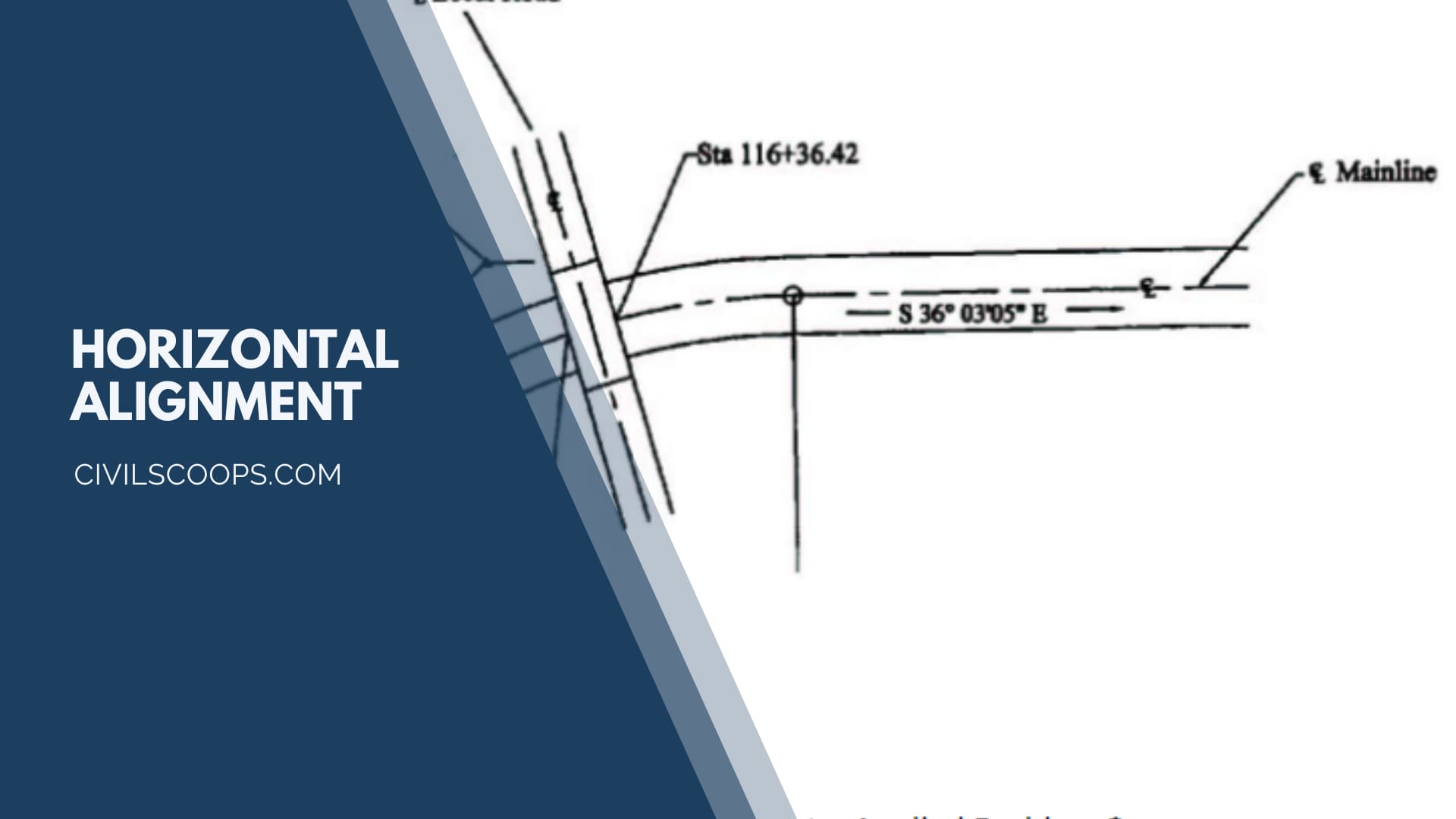
- Horizontal alignment is a straight portion of the road that is connected by suitable curves.
- All the curves of roadway need a superelevation for banking of the curve, to resist vehicles from slipping and allow all the vehicles to run at a uniform speed.
- Horizontal alignment is designed on some basic rules and regulations like driver limitations, curve radius, vehicle characteristics, cost, profile, design speed, etc.
Also Read: Road Gradient | Type of Gradient | All Gradient Advantages and Disadvantages
Classification of Horizontal Alignment:
There are mainly four types of classification observed, those are-
- Simple Curve.
- Spiral Curve.
- Reverse Curve.
- Compound Curve.
An object of Horizontal Alignment:
- Horizontal alignment increases the adequate level of the user.
- Horizontal alignment secures the safety of the road user.
Vertical Alignment of Road:

The vertical alignment of the road comprises gradients and vertical curves. Vertical alignment is defined as the height and depth in a vertical axis with respect to the horizontal axis, this height, and depth create a gradient and vertical curve.
Vertical alignment of the roadway consists of the following factors-
- Gradient.
- Grade Compensation.
- Vertical Curve.
1. Gradient
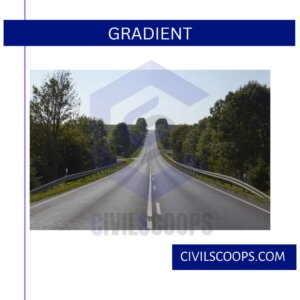
The gradient is the rise and fall of the gradient with respect to the horizontal line.
Gradients are mainly four types those are-
a. Ruling Gradient:
- This type of gradient is the maximum gradient that is provided on the highway. It is also termed the designer gradient.
- The ruling gradient depends on terrain length, speed, power of the vehicle, etc.
- The ruling gradient in hilly terrain is difficult to provide.
b. Exceptional Gradient:
This type of gradient is a very exceptional gradient, and it’s a very steeper gradient. The length of this gradient should not be less than 100 m.
c. Limiting Gradient:
- A limiting gradient is provided in shorter stretches on the highway.
- When the limiting gradient is costlier, then we provide a limiting gradient.
Also Read: 19 Different Types of Slabs in Construction | What Is a Slab | Types of Slabs
d. Minimum Gradient:
- For the drainage purpose of rainwater, the minimum gradient is required.
- For concrete drain, 1 in 500 slopes is provided, and soil drain 1 in 200 slopes is required.
2. Grade Compensation:
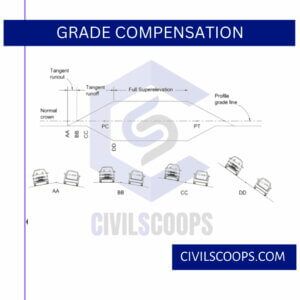
When the horizontal curve lies in a vertical curve, then there is resistance is created by a circular curve.
IRC specifications for grade compensation-
- For grades that are flatter than 4%, then grade compensation is not needed.
3. Vertical Curve:
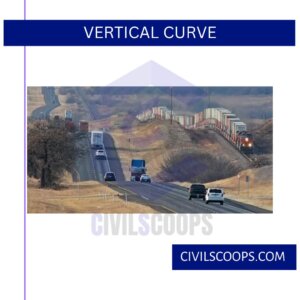
There are mainly two types of vertical curves are exist, they are-
a. Summit Curve:
- This type of curve is a vertical curve mainly used in the upward gradient.
- If the summit curve is a parabola in shape, then it’s considered the best curve.
b. Valley Curve:
- We provide the valley curve when the gradient is downward.
- When a vehicle entered a downward gradient, then it catches more speed, so the valley curve provides a suitable sight distance for comfort.
[su_box title=”FAQ” style=”default” box_color=”#333333″ title_color=”#FFFFFF” radius=”3″ class=”” id=””]
Alignment of Road
The alignment is the route of the road, defined as a series of horizontal tangents and curves. The profile is the vertical aspect of the road, including crest and sag curves, and the straight grade lines connecting them
Road Alignment Meaning
The alignment is the route of the road, defined as a series of horizontal tangents and curves. The profile is the vertical aspect of the road, including crest and sag curves, and the straight grade lines connecting them
Road Alignment Design
Alignment. Horizontal alignment in road design consists of straight sections of the road, known as tangents, connected by circular horizontal curves. Circular curves are defined by radius (tightness) and deflection angle (extent).
Alignment Principle of Design
Alignment is one of the most important design principles. It helps ensure a sharp, ordered appearance for ultimately better designs by ensuring your various elements of the design have a pleasing connection with each other
Horizontal Alignment Road Design
The horizontal alignment is the route of the road, defined geometrically as a series of horizontal tangents (straight roadway sections), circular curves, and spiral transitions. It shows the proposed roadway location in relation to the existing terrain and adjacent land conditions
What Is Vertical Alignment in Road Design
Vertical curves are used to provide a smooth transition between roadway grades. A vertical curve is composed of a parabolic curve that provides a constant rate of change of grade. A parabolic curve “flattens” the vertical alignment at the top or bottom of a hill to increase the driver’s sight distance
What Is Horizontal Alignment in Road Design
The horizontal alignment of a roadway is defined in terms of straight-line tangents and horizontal curves. The curves allow for a smooth transition between the tangent sections. Circular curves and spirals are two types of horizontal curves utilized to meet the various design criteria
Geometric Design of Road
Geometric design refers to the dimensions and arrangements of the visible features of a roadway. This includes pavement widths, horizontal and vertical alignment, slopes channelization, intersections, and other features that can significantly affect the operations, safety, and capacity of the roadway network
Gradient Road
A road gradient is a longitudinal slope provided to the formation level of a road along its alignment. “Gradient of Road is defined as the rate of rising or falls along the length of the road with respect to the horizontal alignment”
Road Gradient Standards
In the United States, the maximum grade for Federally funded highways is specified in a design table based on terrain and design speeds, with up to 6% generally allowed in mountainous areas and hilly urban areas with exceptions for up to 7% grades on mountainous roads with speed limits below 60 mph (95 km/h).
Vertical Curves in Highway Engineering
Vertical curves are used to provide a smooth transition between roadway grades. A vertical curve is composed of a parabolic curve that provides a constant rate of change of grade. A parabolic curve “flattens” the vertical alignment at the top or bottom of a hill to increase the driver’s sight distance
What Is the Meaning of Road
A wide way leading from one place to another, especially one with a specially prepared surface that vehicles can use.
Road Use
A road is a linear way for the conveyance of traffic that mostly has an improved surface for use by vehicles (motorized and non-motorized) and pedestrians. Unlike streets, the main function of roads is transportation
Alignment of Highway
The roadway horizontal alignment is a series of horizontal tangents (straight roadway sections), circular curves, and spiral transitions. It shows the proposed roadway location in relation to the existing terrain and adjacent land conditions.
Vertical Alignment of Road
The vertical alignment of a new roadway is established by locating all of the points of intersection (VPIs), at which the grade of the roadway must change. The VPIs are then connected by straight lines to create the tangent portions of the vertical alignment
Horizontal Alignment of Road
The horizontal alignment of a roadway is defined in terms of straight-line tangents and horizontal curves. The curves allow for a smooth transition between the tangent sections. Circular curves and spirals are two types of horizontal curves utilized to meet the various design criteria.
[/su_box]
[su_note note_color=”#F2F2F2 ” text_color=”#333333″ radius=”3″ class=”” id=””]
Like this post? Share it with your friends!
Suggested Read –
- All About Sand | What Is Sand | 29 Types of Sand | Composition of Sand
- 19 Different Types of Slabs in Construction | What Is a Slab | Types of Slabs
- All About Gypsum Plaster | What Is Gypsum Plaster | 15 Advantage of Gypsum Plaster | Disadvantage of Gypsum Plaster
- All About M Sand | What Is M Sand | Properties of Manufactured Sand | Advantages & Disadvantages of Manufactured Sand
- All About Uscs | Which Test Gives a Better Estimation of the Friction Angle | Introduction of USCS ( Unified Soil Classification System )
[/su_note]
Originally posted 2023-02-25 13:05:49.
